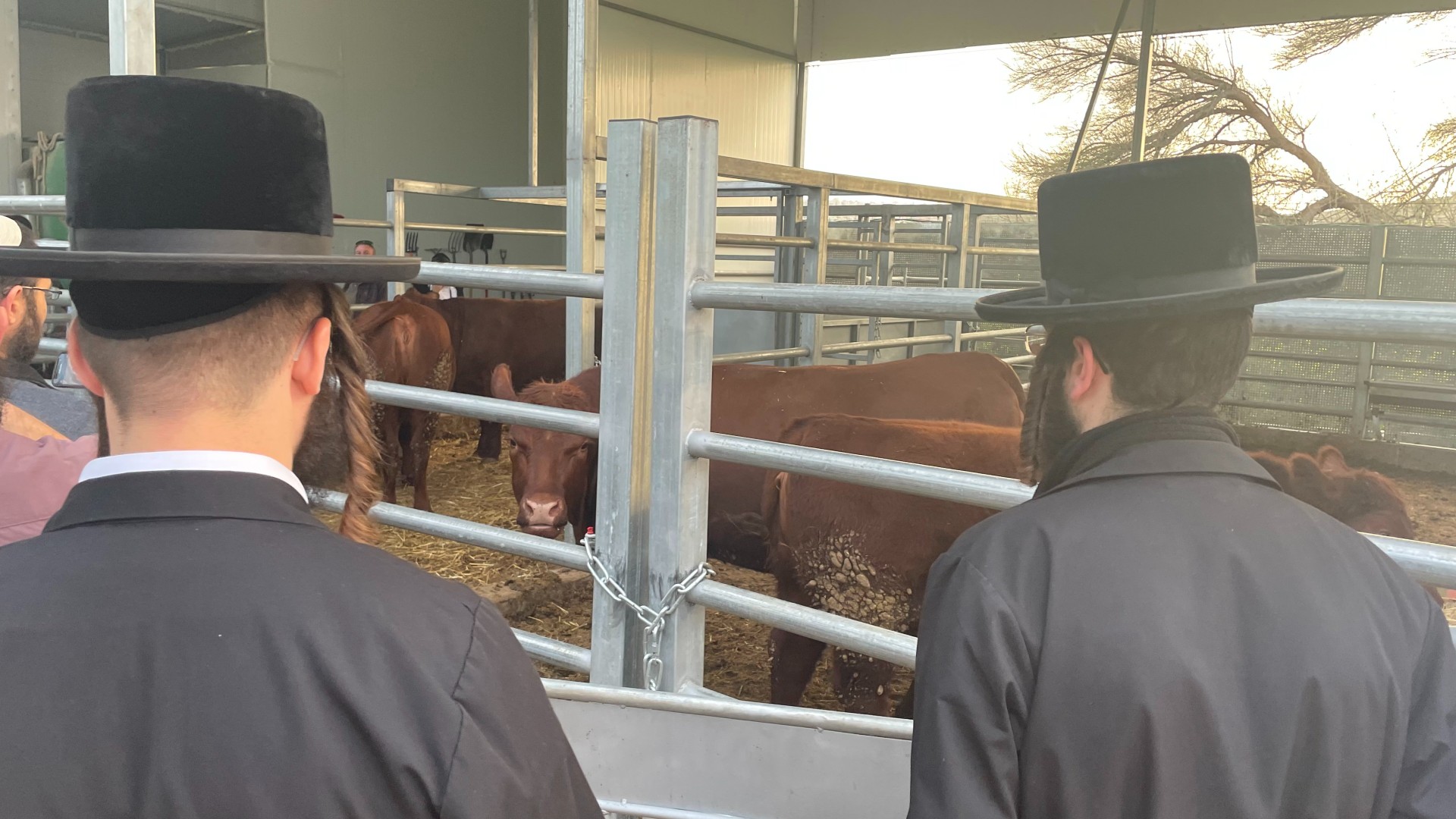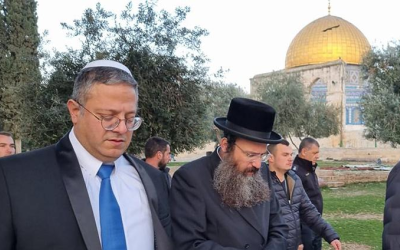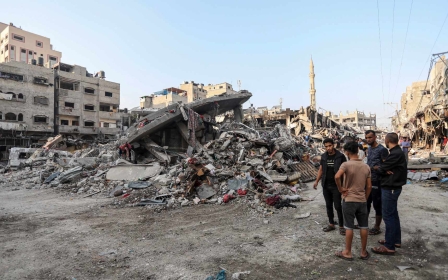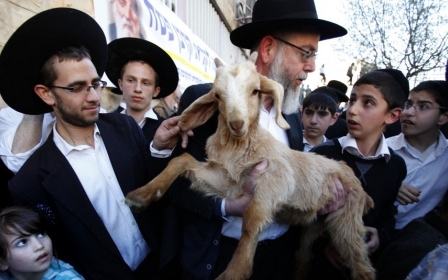In a West Bank settlement, Israelis tend red cows and plan the Third Temple

On the crest of a hill in the occupied West Bank, five Red Angus cows chomp sombrely on some straw. Around them, a group of Israelis look on in anticipation.
If all goes to plan, these cows could herald the end of the world as we know it.
According to Jewish tradition, the ashes of a perfectly red heifer cow are needed for the ritual purification that would allow a Third Temple to be built in Jerusalem.
That temple, say radical Jewish groups, must be constructed on the raised plateau in Jerusalem’s Old City known as the Temple Mount, where Al-Aqsa Mosque and the Dome of the Rock shrine stand today. Some believe this will herald the arrival of the messiah.
On Wednesday, a few dozen Israelis gathered at a conference on the outskirts of Shilo, an illegal Israeli settlement near the Palestinian city of Nablus, to discuss the religious importance and imperative of the cows, and catch a glimpse of them too.
“This is a new moment for Jewish history,” Chaim, a 38-year-old Israeli settler, told Middle East Eye as he prepared to take his seat.
For years, members of the Third Temple community, led by the Jerusalem-based Temple Institute, which organised the conference, have been searching for a red heifer that fits the description of those used for purification in the Torah.
Perfect cows must not have a single blemish, not a stray white or black hair. They can never be placed under a yoke or put to work.
“These cows were brought all the way from Texas and were reared in special conditions to maintain their purity,” said Yahuda Singer, a 71-year-old from the Mitzpe Yericho settlement and the translator of a pamphlet on red heifers.
“The cows can’t even have someone lean on them,” said Singer’s wife Edna, 69. “You can make them impure by just placing your jacket on their back.”
The perfect cow hasn’t been seen for 2,000 years. Not since the Romans destroyed the Second Jewish Temple - which is believed to have stood at the top of the Temple Mount - in AD 70 has the perfect red heifer been glimpsed.
So some Jewish activists, alongside US evangelical Christians who believe the construction of the Third Temple will prompt the second coming of Jesus and Armageddon, decided to breed their own.
In 2022, five of these promising young cows, blessed with glossy ochre hides, arrived in Israel from a Texas ranch with much fanfare. Now you can find them in an archaeological park, separated from biblical ruins and flowering rosemary bushes by a high steel pen.
'Hezbollah found out about this event'
In many ways, the red heifer conference was like any other. Rabbis and religious scholars delved into the details of the Torah. A couple of people in the crowd gently nodded off under the dimmed lights.
In other ways, it was unique. The first two speakers stood at the lectern with assault rifles slung around their shoulders.
“Hezbollah found out about this event and have been talking about it on Telegram,” Kobi Mamo, head of the ancient Shiloh archaeological site, said in his opening remarks.
MEE was unable to unearth any of this kind of talk from the Lebanese armed movement, which fired a barrage of rockets into northern Israel earlier that day, but the conference nonetheless attracted a lot of attention on Arabic social media.
One person in Libya joked that the red heifer found on the front of packets of Laughing Cow revealed that the spreadable cheese triangles are a Zionist conspiracy. “Have you ever asked yourself why the laughing cow is red!!??” he asked.
Others more seriously suggested that there were plans to imminently slaughter a heifer on Jerusalem’s Mount of Olives, where land was bought up by Third Temple activists for this purpose.
Rabbi Yitzchak Mamo, from the Third Temple group Uvne Jerusalem, previously told the Christian Broadcasting Network that a ceremony was planned for Passover this year, which comes in late April.
Hamas, the Palestinian movement fighting Israel in Gaza, has raised concerns about the cattle.
In November, a senior Palestinian source in contact with Hamas’ leadership told MEE that the group had been closely monitoring efforts to secure a permanent Jewish presence in Al-Aqsa Mosque.
“The only thing left is the slaughtering of the red heifers, which they imported from the US. If they did that, it’s the signal to rebuild the Third Temple,” said the source.
In January, Abu Obaida, spokesperson for Hamas’ military wing, made a speech marking 100 days since the group’s 7 October attack on Israeli communities near the Gaza Strip.
In it, he made a direct link between Hamas’ decision to attack Israel and Third Temple activists importing the cattle, which he said was an “aggression against the feelings of an entire nation”.
'All we want is a small altar'
Yaakov, a 19-year-old yeshiva student from Los Angeles who wished to be identified only by his first name, came to Shilo for the chance to see the cows for himself.
“I’ve heard about red heifers and the First and Second Temple all my life, so I’m really excited about the opportunity to see one today,” he told MEE.
Yaakov understands that the prospect of building a Third Temple on the site of Al-Aqsa is controversial, “but I don’t think it should be”.
'These cows were brought all the way from Texas and were reared in special conditions to maintain their purity'
- Yahuda Singer, Israeli settler
“There was once a church there, then a mosque. It was originally a Jewish temple, so it should be again,” he said. “It doesn’t have to be violent.”
Boruch Fishman, a longstanding member of the Third Temple movement, told MEE there is a long way to go between slaughtering a red heifer and building a Third Temple.
He has identified 13 problems that need to be solved before construction can begin - including getting Israel’s parliament, the Knesset, to legalise such a plan. “That’s where I can help on the political side,” he said.
Since Israel conquered and occupied East Jerusalem in 1967, the Israeli government has maintained strict Ottoman-era restrictions over Jewish prayer and presence in Al-Aqsa Mosque's courtyards.
Entry to Al-Aqsa has also been banned by the Chief Rabbinate of Jerusalem since 1921, with an edict ruling that Jews are forbidden to enter the site unless “ritually clean”, which is impossible without the ashes of a red heifer.
Yet as Israeli politics and society has shifted towards the religious right, allowances have been made for some Jewish Israelis - almost always settlers - to regularly visit the site under armed guard.
The Third Temple community hope the slaughter of Shilo’s red cows will allow Jewish people to be purified so they can perform rites and worship in the mosque’s courtyards. Research by a professor at Bar Ilan University estimated that the ashes of one cow could be made into enough cleansing water for 660 billion purifications.
“One of the main issues is the Waqf,” says Fishman, referencing the Jordanian-run Islamic endowment that manages Al-Aqsa. “The Waqf gets a lot of money from Jordan and I don’t think they want to give that up.”
According to Fishman, small steps need to be taken to secure a Jewish presence on the Temple Mount. “The Muslim community is hurting a lot right now, and we need to be sensitive,” he said. “All we want is a small altar.”
Some Third Temple activists and rabbis have previously sought to perform ritual sacrifices in Al-Aqsa’s courtyards at Passover, only to be turned away by Israeli soldiers.
“Perhaps the Waqf could be persuaded to help collect offerings and raise money that way,” Fishman said.
“Of course, not everyone could come with something to sacrifice, it would be a bloodbath. But I believe there is a difference between what the Waqf says in public and private, and it could be convinced.”
In response, Waqf spokesperson Firas al-Debs told MEE: “Let them say whatever they want in their conferences. The Waqf always emphasises in its statements its decisive opinion that Al-Aqsa Mosque is for Muslims only and that it doesn’t accept partnership or division.
“There is no value in what is discussed in these conferences as long as they are not official," he added.
This article is available in French on Middle East Eye French edition.
Middle East Eye propose une couverture et une analyse indépendantes et incomparables du Moyen-Orient, de l’Afrique du Nord et d’autres régions du monde. Pour en savoir plus sur la reprise de ce contenu et les frais qui s’appliquent, veuillez remplir ce formulaire [en anglais]. Pour en savoir plus sur MEE, cliquez ici [en anglais].







